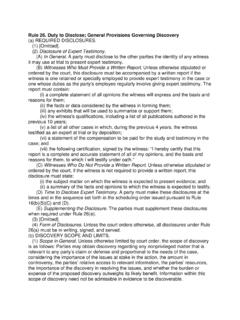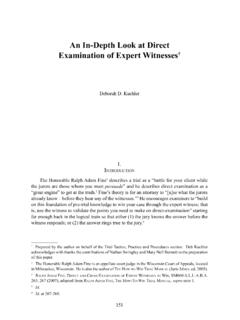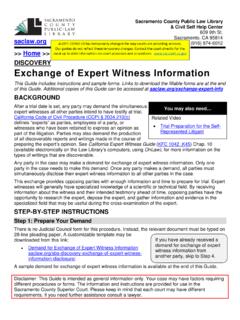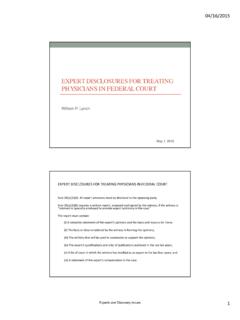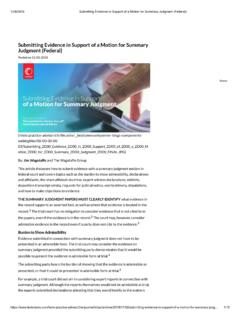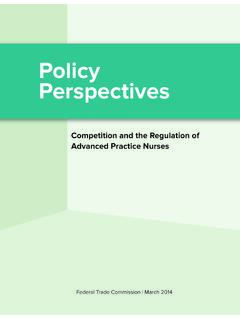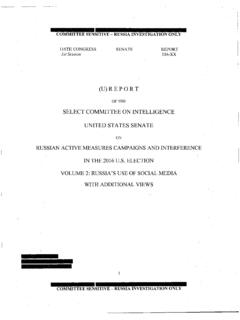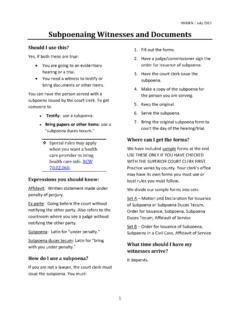Transcription of Ten Tips for Direct Examination and Cross-Examination
1 Ten Tips for Direct Examinationand Cross-ExaminationWalter W. Bates R. Todd Huntley William S. Starnes, Jr. IntroductionThere are textbooks and treatises devoted to the intricacies of directand Cross-Examination . Even so, every detail necessary for effectiveexamination of witnesses cannot be found in a single source. Such1unfound details are practical skills and require years of learning, practice,and experience. This Article outlines ten tips for both Direct and Cross-Examination , which certainly is not an exhaustive list. Other thanpreparation, these tips are not listed in order of importance. Ten Tips for Direct is absolutely no substitute for hard work. You must master boththe facts and subject matter of your case. You must know the judge, the (1978), University of Alabama; (1981), Cumberland School of Law. Mr. Bates is a partner in the Birmingham, Alabama law firm of Starnes Davis Florie LLP.
2 (1996), Auburn University; (2000), Cumberland School of Law. Mr. Huntley is a partner in the Birmingham, Alabama law firm of Starnes Davis FlorieLLP. (2007), Auburn University; (2010), Cumberland School of Law; MBA (2010), Samford University. Mr. Starnes is an associate in the Birmingham, Alabamalaw firm of Starnes Davis Florie Article is based on a presentation by Mr. Bates at a symposium TheAlabama Trial Attorney: Litigation Lessons from Birmingham s Finest sponsoredby the Cumberland Law Review on November 20, 2015, at Cumberland School of Law. See FRANCIS WELLMAN, THE ART OF Cross-Examination 122 (1919) ( I am of theopinion that it is impossible to embody in any set of rules the art of Examination ofwitnesses.. ), originally in FRANCIS WELLMAN, THE ART OF CROSS-EXAMINATION135 (1903).340 AMERICAN JOURNAL OF TRIAL ADVOCACY[Vol. 39:339witness, and the jury.]
3 Your job on Direct Examination is to have thewitness tell the story, which cannot be done effectively unless you knowevery nuance of the case. Direct Examination requires you to ask everyquestion with a purpose. If you represent the plaintiff, ask yourself howthe witness helps you satisfy your burden of proof. Practitioners shoulduse Pattern Jury Instructions as a must prepare every witness. Meet with your witnesses and covertheir expected testimony and practice with each witness so they knowwhat to expect. Witnesses obviously cannot memorize every answer, butthey should never be surprised on Direct Examination . Tell your witnesseswhen they appear ambiguous or uncertain. Because every question ondirect should be a home run pitch for the witness, every answer shouldbe powerful, truthful, concise, and confident. Witnesses should be familiar with the magic words or legal termsthat may arise upon questioning.
4 If a witness is going to discuss a treatiseor piece of literature on a subject, the witness needs to know how toestablish the treatise as a reliable authority. If a witness is going to testifyto causation, that witness needs to know the legal difference between probable and possible. Familiarize your witnesses with the courtroom. Tell each witnesswhere to sit and where the judge and jury are located. If you can, takeyour witnesses to the courthouse and show them the courtroom. Let yourwitness sit on the witness stand so she can understand the jury s vantagepoint. Such courtroom familiarity helps the witness and relieves anxietyin what will certainly be an uncomfortable every witness you intend on calling, have the following ready fortrial: Copies of witness statements; Copies of deposition testimony ; Copies of deposition summaries; Confirmation of service of subpoenas; Documents to be used in support of testimony .
5 These documentsshould be included with other exhibits, and your outline shouldreference the document by name and description in your trialnotebook; See, , Ala. Pattern Jury Instr. Civ. (3d ed. 2014) (stating a plaintiff must2prove to a reasonable satisfaction that her contentions are true). 2015]TEN TIPS FOR Direct Examination AND CROSS-EXAMINATION341 Direct Examination outlines; and3 Evidentiary rules or case law to combat anticipated objections. it Simple Learn to talk like a regular person wherever you are. In the officeor at home. In court or out. And write like a regular person for bothpersonal and professional matters unless you have a very good reasonfor using a precise legal term of art .. Avoid using legalese in4court it is a poisonous set of verbal habits that we unconsciously turnon or off . With witnesses, [a]sk a stiff question and you ll get a stiff5answer.
6 Ask a long, rambling question and you ll get a long, ramblinganswer. Ask an incomprehensible question and you ll get an incompre-hensible answer or no answer at all. Brevity can be key. Short6questions command instant comprehension from both the witness andthe jury. The longer the question, the more you are likely to inject seriousconfusion. 7 For Direct Examination , try to begin each question with who, what,when, where, how or why. Think about this for every topic you plan8to cover with the witness, because part of your job is to make sure thejury hears the whole story from the witness. Lawyers easily forget thatthe jury does not know the case as well as the lawyers. As a lawyer, youknow the depths of your witness s testimony and how your witness knowsthe substance of her testimony , but the jury does not. A lawyer s failureto qualify the witness is a missed opportunity to develop credibility withthe jury.
7 See E-mail and Attachments from Terry Gatewood, Judicial Event Specialist, to3 Billy Bates (May 17, 2010, 10:17 CST) (on file with author). James McElhaney, Persuasive Direct , J. (Jan. 1, 2009, 6:19 AM), James McElhaney, Direct Answers: Examining a Witness Is Telling a Story So7 Make it a Good One, J. (May 1, 2012, 7:49 AM), JOURNAL OF TRIAL ADVOCACY[Vol. 39 Topic Sentences or Headers Direct Examination is not the same as having a conversation. Itshould sound like one, but it [is not]. Do it right, and you guide thewitness every step of the way, without ever sounding like you re puttingwords in the witness s mouth. Guide the witness by using the headline9method of Direct . Under the headline method of Direct , [b]efore eachnew series of questions, announce the topic: the headline that tells thewitness and everyone else what the subject is going to be.]
8 The10headline method of Direct is also referred to as the paragraph method. 11 For example, Dr. Smith, I am going to ask you about Mr. Jones s medicalhistory. How long were you his primary care physician? The headline12method can be used to get wandering witnesses back on track. For13example:Dr. Smith, I am going to ask you about everything you did duringsurgery, but first I want you to tell the jury what you and Mr. Jonesdiscussed before the surgery. Although topic sentences and headers are helpful, avoid using superfluousintroductory phrases. Statements like Let me ask you this .. and , isn t it true that .. annoy the jury and distract from the witness the WitnessIt is important during Direct Examination to give the jury a chance toget to know the witness personally. Establish your witness s credibility See James W. McElhaney, The Case Is Falling Apart.
9 And Continuity Is the11 Glue that Keeps Things Together, J. 74, 74 (1998) ( [S]tart using the paragraphmethod of Direct Examination . Break down everything you need from the witness intoa series of simple paragraphs, and think of a short simple title for every subject. ). Use a simple declarative statement designed to orient everyone judge, jury and12witness and give meaning to the questions that [follow]. James McElhaney, Keepit Simple, J. (July 1, 2010, 8:00 AM), McElhaney, supra note ]TEN TIPS FOR Direct Examination AND CROSS-EXAMINATION343and ask your witness questions that demonstrate her relationship with thecase. It is crucial to help the jury understand why they should like yourwitness, and the jury should be able to identify with your witness. However, if a witness is only there to address a few evidentiary issues,such as a records custodian to authenticate records, it is best to do a basicintroduction so you can move quickly to the important reason the witnessis there.
10 Humanizing witnesses helps the witnesses feel comfortable in frontof the jury:If [witnesses] are alarmed or diffident, and their thoughts are evidentlyscattered, commence your Examination with matters of a familiar character,remotely connected with the subject of their alarm, or the matter in issue;as, for instance, Where do you live? Do you know the parties? How longhave you known them? etc. And when you have restored them to theircomposure, and the mind has regained its equilibrium, proceed to the moreessential features of the case, being careful to be mild and distinct in yourapproaches, lest you may again trouble the fountain from which you are following topics can be covered to help the jury identify with thewitness: Where the witness was born and raised; Her parents occupations; Any information on siblings; Any information on spouse and children; The witness s educational background; Whether the witness served in the military; Whether the witness has been involved charitable or mission work; Honors or awards the witness has received; Any civic involvement; and Whether the witness holds any leadership the weakest witness possesses strengths.
